|
Printables |
PowerPoints |
Online exercises |
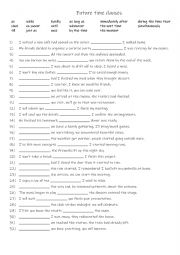
|
B1-B2 17 future time clauses
Students familiarise themselves with the 17 future time clauses and their uses. Then they read the sentences to work out which adverb is required to complete the gap-fill. Answers on page 2.
Level: intermediate
Age: 10-100
Type:
Downloads: 110
|
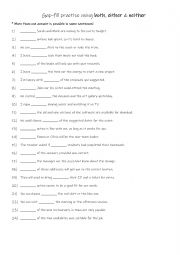
|
A2-B1 Gap-fill practise using both, either & neither
Students familiarise themselves with the determiners / conjunctions and their usage. Then they read the sentences to see which word is required to complete the gap-fill. Each determiner / conjunction is used 8 times. Answers on page 2.
Level: elementary
Age: 9-100
Type:
Downloads: 110
|
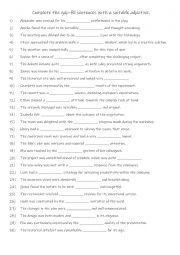
|
B2-C1 Complete the gap-fill sentences with a suitable adjective.
Students read the sentences and complete the gap-fill with a suitable adjective.This worksheet could be used individually, in pairs or small groups.If a team has a different adjective to the others they get 3 points for a suitable adjective and when the same adjective is used by 2 or more groups only 1 point is given. Possible answers are on page 2...
Level: advanced
Age: 11-100
Type:
Downloads: 110
|
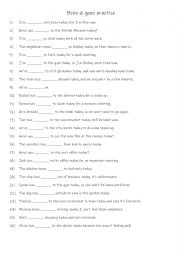
|
A2+-B1 Been & gone practise
Using "been" and "gone" properly helps students master the present perfect tense, which is essential for expressing completed actions that still impact the present.Misusing these words can lead to confusion about whether someone is still at a place or has already returned, so learning the difference is essential for clear communication. Each word i...
Level: intermediate
Age: 9-100
Type:
Downloads: 110
|
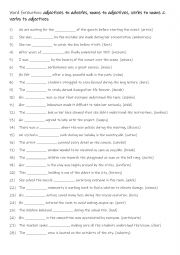
|
B1-B2 Word formation -adjectives to adverbs, nouns to adjectives, verbs to nouns & verbs to adjectives
Understanding word formation allows students to expand their vocabulary, enabling them to express themselves more precisely and creatively. Knowing how to manipulate words helps them create varied sentence structures, making their writing more engaging and dynamic.Mastering word formation is key to achieving higher levels of language proficiency, p...
Level: intermediate
Age: 9-100
Type:
Downloads: 110
|
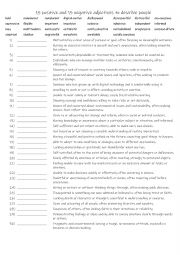
|
B1+-B2 15 positive and 15 negative adjectives to describe people Part 2
First, students look at the quite challenging 30 adjectives to familiarise themselves with the meanings. Then,they read the definitions and write the corresponding adjectives in the space provided. This worksheet after being checked could be used as a speaking reinforcement activity in pairs or small groups. Answers on page 2.
Level: intermediate
Age: 9-100
Type:
Downloads: 110
|
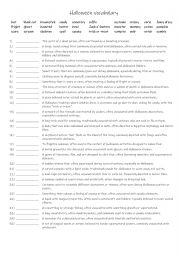
|
A2-B1 Halloween vocabulary - 30 words
Students familiarise themselves with the 30 Halloween related words and their meanings. Then they read the definitions and write the word being described in the space provided. Answers on page 2.
Level: elementary
Age: 8-100
Type:
Downloads: 110
|

|
B1-B2 Prepositions + gerunds 2
Many English expressions rely on specific prepositions and gerunds. Mastering these can improve fluency and make language sound more natural. Using the correct prepositions and gerunds can elevate students writing style, making it more varied and engaging. First, students need to familiarise themselves with the 30 gerunds and prepositions to check ...
Level: intermediate
Age: 9-100
Type:
Downloads: 110
|
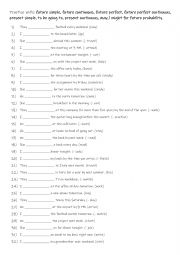
|
B1-B2 Practise with future simple, future continuous, future perfect, future perfect continuous, present simple, to be going to, present continuous, may / might for future probability.
Learning these future tenses and structures (future simple, future continuous, future perfect, future perfect continuous, present simple, to be going to, present continuous, may, and might for future probability) is crucial for students because they help express different types of future actions and possibilities. For example, the future simple is ...
Level: intermediate
Age: 8-100
Type:
Downloads: 110
|
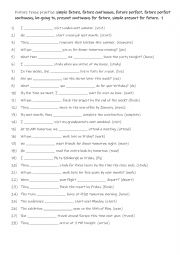
|
B1-B2 Future tense practise simple future, future continuous, future perfect, future perfect continuous, be going to, present continuous for future, simple present for future. 1
Using these future tenses helps students express future actions clearly. They can use simple future for predictions and decisions, future continuous for ongoing actions, future perfect for completed actions by a future time, and future perfect continuous for actions that will be ongoing up to a point in the future. Be going to is used for plans or ...
Level: intermediate
Age: 10-100
Type:
Downloads: 110
|
|
|
|
|












